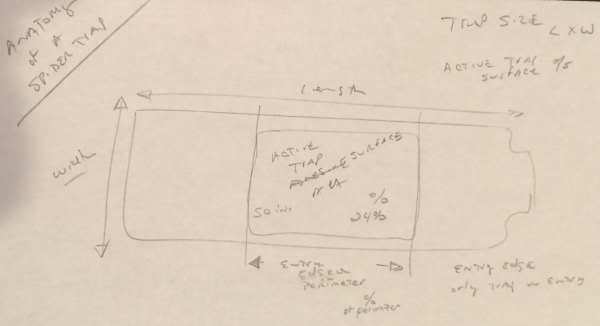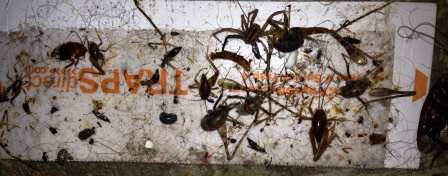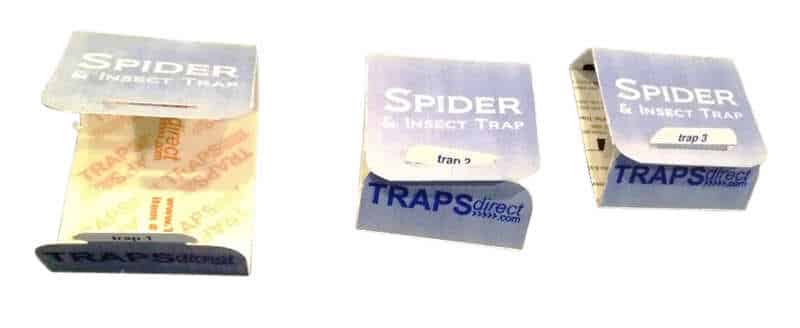Sure it might seem strange to refer to a spider (or insect trap) as having an anatomy. Everyone know the basics of a spider’s anatomy ( 4 pair of legs and a 2 sectioned body). But when it comes to describing the anatomy of a spider trap it goes beyond any one of product packaging, construction materials, assembly method, placement options, warning zones or edge-to-edge active trap surface. Spider Trap Anatomy needs to include all of these elements..
I am not going to try some clever mapping of the spider trap package as the skin of the trap, and follow into the construction materials as bones, and the adhesive sticky area as the heart, because it just doesn’t make sense and fell apart (yes, I had tried to make it work, but it won’t).
Instead, I’ll describe the major aspects of a spider trap by category and attributes. For example, Product Package : Materials – Color.
In each category I’ll try to include objective metrics that you could use to compare one brand of spider trap to another. For example a Product-to-Package ratio or trap edge length ( you can compare how many inches of trapping edge are present). When there are uncommon terms, I’ll include a brief definition and a link to a more detailed post if the term warrants.
So to get started we’ll scratch the surface of each of these major areas ( additional articles will be published with details, pros and cons and open discussion) and include the major attributes of each:
Spider Trap Packaging
Of course we are talking about the container holding the traps. Sustainable packaging is the obvious preference, but I’ll also look at the space the product occupies ( sometimes called dimensional or volumetric weight) because larger dimensions drive a higher carbon foot print.
Package Overview:
Including dimensions (Length, depth, width, sq inches), product-to-package ratio (identify excessive packaging), dimensional space per trap (compare carbon footprint)
Package Material:
Outer Package (poly, cardboard)
Package Appearance:
Messages (Spider trap Name, target insects, marketing messages), Markings (QR-Code, UPC, EAN, Stock code, EPA registration number), Languages (English, Spanish , French, etc), Color(s).
Trap Construction
I’ll explore the single spider trap, what is the shape, glue board material, size, scoring, cuts or bends, and color.
Trap Material
Including Flat Trap vs Glue Well and individual trap dimensions ( outer length, width, area, thickness) and geometry ( square corners vs rounded).
Trap Geometry
An aspect trap appearance, we’ll look at utility (square corners) vs Decora (rounded edges)
Trap Assembly
Here we’ll be looking at the cut outs ( slot (shaped, or slit), tab ( rounded, angled ) and helpers ( pre-folded bends or perforations)).
Spider Trap Appearance
Separated into both Trap Outside and inside ( Color, Markings, Logo, Messages)
Active Trap Field
The heart of the spider trap (I know, it really is the only part that makes body part sense) is the active trap field (ATF), the sticky surface, the glue of the glue board.. This is where insects get trapped, and the trap earns its keep. You might think that this is a simple category, but it actually has a few variables that really matter:
Active Trap Field Metrics
These metrics allow an objective comparison of the trap’s effectiveness:
cATFe – Cost per Active Trap Field Entrance
Objective metric to compare traps to one another. $ / # / ATFe
Trap Package $ / Traps in Package / ATFe = Cost per active trap field entrance.
ATFe – Active Trap Field Entrance :
Sum of the sides of the trap an insect where an insect can enter the trap.
Written as a score followed by units ATFe : 6 ATFe or 14 ATFe
If the trap contains a Zero Warning Edge, it is added to the score, and the percentage is indicated after AFTe. For example a Spider Trap with 3″ entry, and one side is Zero Warning the ATFe is 3″ left side + 3″ right side + 3″ Zero Warning totals 9″ and 50% of the sides are Zero Warning so it is written as 9 AFTe (50).
ATFz – Active Trap Field Zero :
Sum of the sides of the trap where an insect can enter, WITH OUT warning. This means no leading edge. The sticky surface occurs without warning which leads to an increased catch rate. For traps with an ATFz, it is added to the ATFe to represent the increase in effectiveness of a zero warning edge.
ATFa – Active Trap Field Area :
Active Trap Surface area calculated Length X Width
Active Surface Medium
What type of Glue surface does the trap use (rodent glue, mouse glue, ULC ), pre-baited (synergistic bait , integrated bait, no bait )
Warning Zone
A fatal flaw in crawling insect traps is the warning zone. This is the space where the trap begins, but the leading edge of the active trap field (glue) has not started. The warning zone alerts the target insect of a change in the surface which can spook some spiders and other insects. Ideally a trap uses edge-to-edge trapping which is the same as NO WARNING ZONE. A warning zone is less of a concern as the insect size increases.
edge-to-edge trapping
The first encounter with a spider trap should be the active trap field. In an edge-to-edge trap there is no warning zone the first step contacts the active trap field, and depending on the insect can be the last (depending on the number of legs, millipedes and centipedes may still be able to escape). Spider traps using edge-to-edge design catch more insects.
Trap Directions
Instructions for assembly, placement and any additional assistance will be included here. If / When possible photos or actual text from the spider traps may be included.
Assembly Instructions:
How simple is the assembly, basic directions, # of shapes
Placement Advise:
What do the instructions say about where should traps be placed, how long they should last, how to dispose of the used traps
Additional Information:
Is there any thing else: Reorder information, Material Safety Data Sheet, Assembly Videos, QR-Codes or Website support links.
Smart Spider Traps
Smart spider traps take into consideration all of these attributes to deliver a low carbon footprint, sustainably packaged and effective spider and insect trap with a long leading edge in an no warning edge-to-edge trapping solution. Give it a try..
Before there were Smart Spider Traps, there were Advantage Spider Traps.



Thanks for the details on the skeleton in the spider trap closet. My pest control service had been using an insect monitor that was covered in bright red lettering with a month by month grid on it. I asked my exterminator if there was a less ‘aggressive’ spider trap he could place. Last month he came by with what he said was a newly released ‘consumer spider trap’. It was a dark green, with no logos or grid on the top, and it looks nice enough that I don’t really notice it. (except when its packed with spiders). It sounds like Traps Direct thought outside the trap.. They are selling the green spider traps on this site.